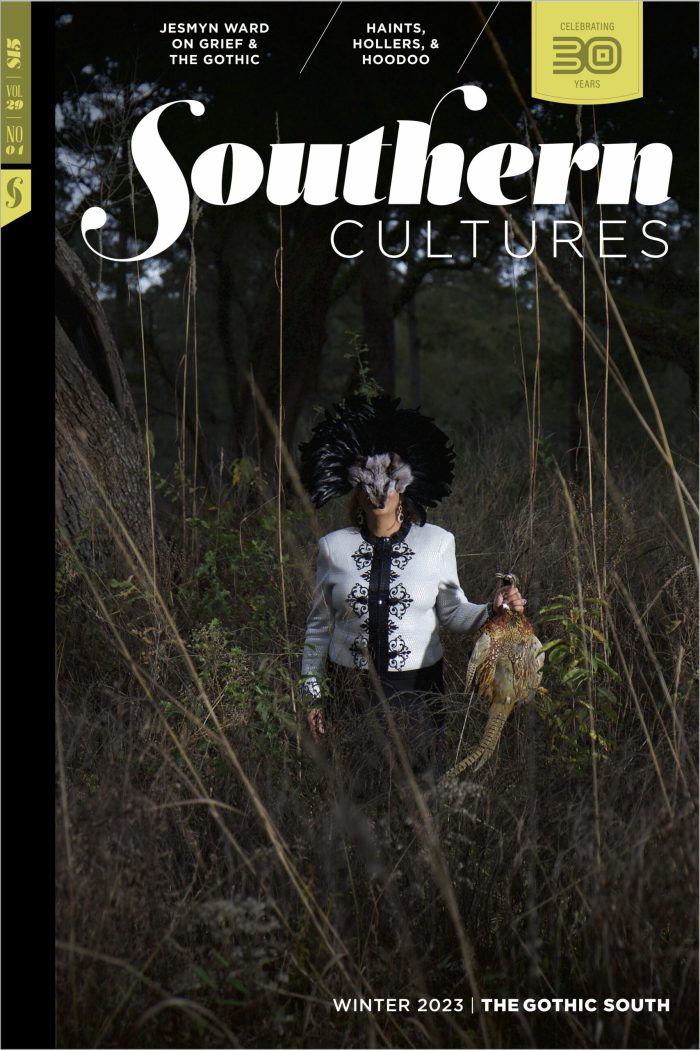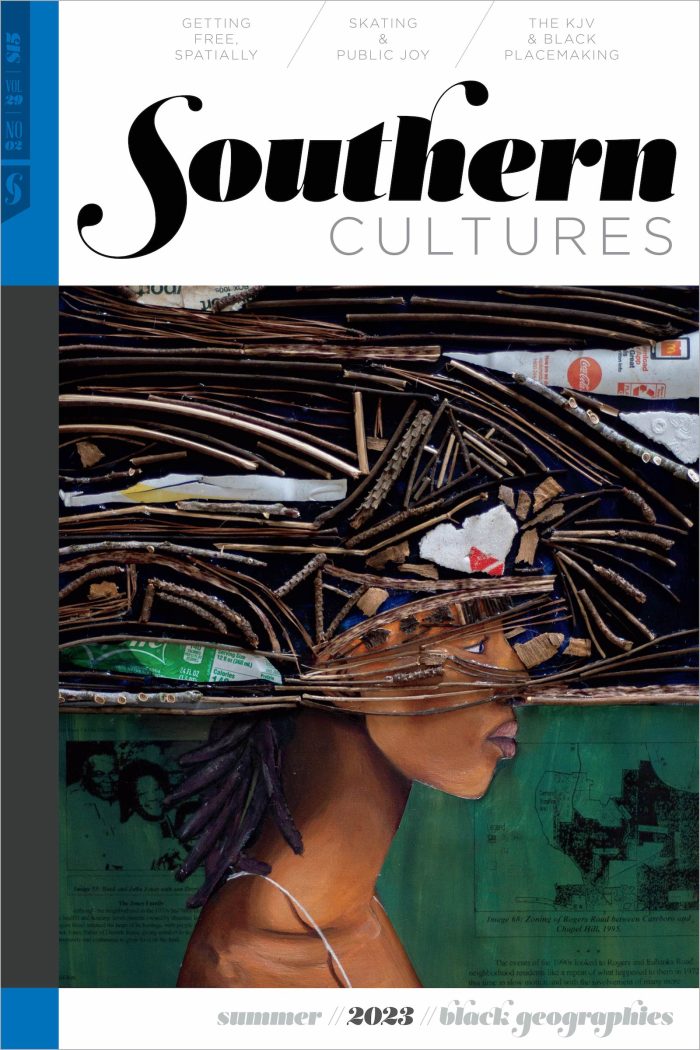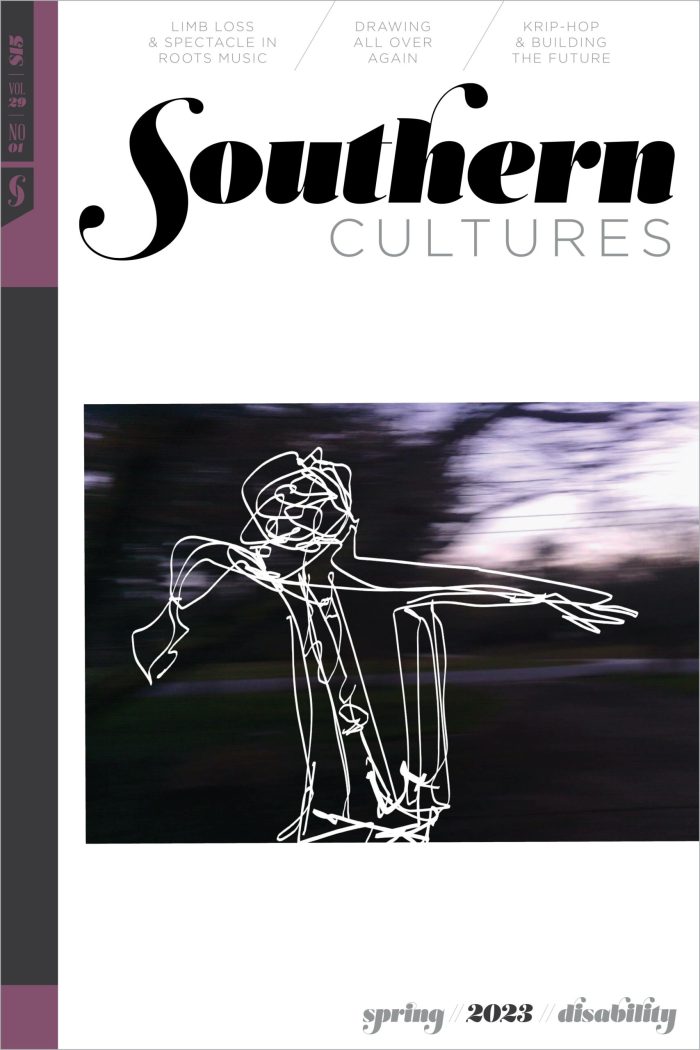BUY ACCESS
by Gloria L. Harbin,
Scott Wyatt
Letters journey across our transom in plain envelopes that usually give no hint of the spicy commentary contained within them. For instance, just before press time for this issue a disgruntled subscriber—who now is a former subscriber—wrote to say: “I won’t order Southern Cultures again due to the politcally-correct, stereotypical beating you administer to white »
BUY ACCESS
by Harry L. Watson
“Prepare to Meet God.” The stark, prophetic warning once glared out from thousands of roadside tree trunks in the twentieth-century South, just as it does from Charlie Curtis’s arresting picture in this issue’s photo essay “Signs of the South.” Sometimes the message was even more unsparingly personal: “Prepare to Meet Thy God.” Whether blazoned on »
BUY ACCESS
by Joseph Crespino
Contemporary debates concerning race in America owe much to the 1960s when African Americans and other minority groups gained basic legal protections and rights of citizenship denied them in the century following Reconstruction. The current offspring of this movement is multiculturalism, a term that encompasses a range of progressive educational techniques, policy recommendations, and social »
BUY ACCESS
by Charlie Curtis
What could a former fashion photographer possibly have to offer Southern Cultures? A tour of the past and present. Charlie Curtis says that it was a deep love for preservation that led to this collection of the archival photography of Dorothea Lange and Marion Post, along with his own original pictures of the signs that »
Essay
BUY ACCESS
Environmental History in and of the American South
by Otis L. Graham
The end of the century proved a poor time to sound the warnings of ecological crisis. That message, called Ecopessimism by the media—despite the fact that people who warn others are optimistic that their listeners can change course—shared the air with the same flock of strange birds that take flight at every century’s close. There »
BUY ACCESS
by John Shelton Reed
University Press of Mississippi, 1999 Among the many things we can blame the 1960s for is the end of the Golden Age of family automobile travel. Ten-hour days of being beaten by a hot, 55-mile-an-hour wind while trying to hear scratchy AM radio stations over the noise of the air and the tires. Sticking hands »
BUY ACCESS
by Stephen W. Berry
Hill Street Press, 1999 Each reproduction in The Lines Are Drawn is a gem in itself, documenting such familiar themes as wartime inflation and scarcity in the Confederacy, northern Copperheadism, and the iconographic rise of Abraham Lincoln and Uncle Sam. In all, Kristen M. Smith has collected 138 cartoons, comics, and caricatures related to the »
BUY ACCESS
by Alphonse Vinh
University of Missouri Press, 1999 The Nashville Agrarian M. E. Bradford once said that a man could be born a southerner and a conservative but not be a Southern Conservative. Clyde Wilson has gathered essays in A Defender of Southern Conservatism that explain what Bradford meant.
BUY ACCESS
by Steven J. Niven
Louisiana State University Press, 1999 Sometimes a writer just gets it right. Fred Hobson does in his brief but enlightening examination of the “white southern racial conversion narrative,” But Now I See. Hobson reviews autobiographical works published by white southern writers since 1940—Lillian Smith, James McBride Dabbs, Will Campbell, Katharine Du Pre Lumpkin, and Pat »
BUY ACCESS
by Fred Hobson
University of Georgia Press, 1998; Farrar, Straus, and Giroux, 1998 From the 1940s until the present—and particularly in the past two decades—autobiography and memoir have been, without doubt, among the most popular forms of southern literary expression. Men and women, Black and white, privileged and poor, straight and gay, southerners of all descriptions have taken »
BUY ACCESS
by David Goldfield
University of North Carolina Press, 1998 Though foreigners often express shock at the sprawling confusion of American cities, Thomas Hanchett demonstrates that there is method in this madness in his analysis of Charlotte, North Carolina. The book is more than a spatial accounting of Charlotte’s neighborhood and business district development. Hanchett places growth in regional, »
BUY ACCESS
by Edward O. Frantz
John Wiley and Sons, 1998 Until this biography, students had to be content with only morsels of information from other publications about civil-rights activist Ella Baker, but Joanne Grant’s narrative traces Baker’s combative spirit back to the legacy of her grandparents, who were former slaves, and stresses a continuity of resistance within the African American »
BUY ACCESS
by William C. Harris
University of Arkansas Press, 1997 This attractive and well-designed photographic history fulfills in admirable fashion Richard McCaslin’s objective: “to present a carefully selected array of images that convey the experience of many citizens of the North State” during the Civil War. A major strength of McCaslin’s volume is the narrative account of North Carolina during »
BUY ACCESS
by Noel Fisher
University of Tennessee Press, 1997 Dunn offers readers not only a well-chosen collection of Ezekiel Birdseye’s provocative letters to New York Abolitionist Gerrit Smith, but also a richly insightful, solidly grounded essay on antebellum East Tennessee. Birdseye, a businessman and abolitionist, possessed a coherent social and moral philosophy—and a wide-ranging curiosity—and his letters take up »
BUY ACCESS
by Gavin James Campbell
Asylum, 1999 For quite some time George Jones has blasted commercial country stations for preferring tight butts and slick packaging over proven, if older, talent. Of course he’s right, but then again he hasn’t done anything in quite some time that really stands out. Well, Shania and Garth, move over, ’cause The Possum’s back. In »
BUY ACCESS
by Gavin James Campbell
The Alabama Center for Traditional Culture, 1999; Verdant Groves Music Foundation, 1999 In 1841 a backwoods Alabama Baptist preacher named Benjamin Lloyd published a words-only hymnal adapted, as he wrote, “to singing on all occasions.” As was customary in Lloyd’s day—and in true Baptist fashion—the tunes to accompany the texts were left up to individual »
BUY ACCESS
by Gavin James Campbell
Rounder, 1999 African American song has permeated the southern air for centuries. From earliest times, whites marveled at the skill with which slaves combined rhythm and work. By 1943 when this recording was originally issued, that centuries-old worksong tradition was slowly dying out. This CD preserves the vestiges of African American musical creativity designed to »
BUY ACCESS
by Gavin James Campbell
Rounder, 1999 As bluegrass looks back on fifty years of tradition, few prominent current bands hew closer to bluegrass’s roots than IIIrd Tyme Out. The group’s tight harmonies and inspired traditionalism have won widespread acclaim, and their latest release will not disappoint fans. In John and Mary they blend well-loved tunes like “Milk Cow Blues” »
BUY ACCESS
Dorsey Dixon's Autobiographical Writings
by Kathleen Drowne,
Patrick Huber
Dorsey Dixon, a forty-year-old weaver then employed at the Entwistle Mill in East Rockingham, North Carolina, was tending his looms one rainy morning in the winter of 1938 when he heard the news of a deadly automobile accident on nearby U.S. Highway 1. After his shift, Dixon and another worker went to view the crumpled »





